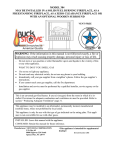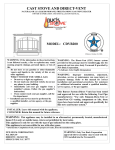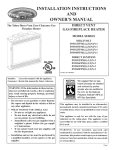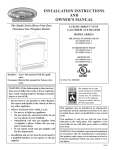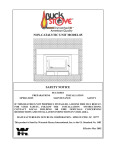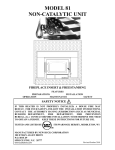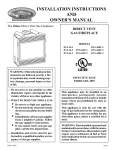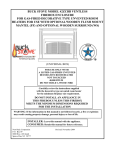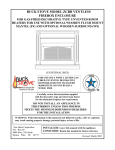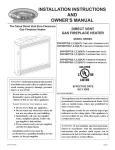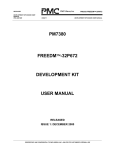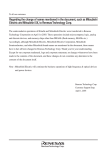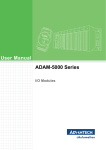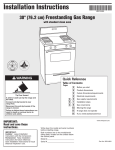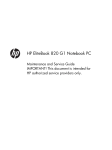Download New Buck Corporation DV1000 User's Manual
Transcript
DV1000 ZERO CLEARANCE DIRECT VENT GAS FIREPLACE WITH L.P. (Liquid Propane) or Natural Gas/ Millivolt System This appliance is not convertible for use with other gases, unless a certified kit is used. Approved By: WARNING: If the information in these instructions are not followed exactly, a fire or explosion may result causing property damage, personal injury or loss of life. ⎯ Do not store or use gasoline or other flammable vapors and liquids in the vicinity of this or any other appliance. ⎯ WHAT TO DO IF YOU SMELL GAS • • • • Do not try to light any appliance. Do not touch any electrical switch; do not use any phone in your building. Immediately call your gas supplier from a neighbor’s phone. Follow the gas suppliers instructions. If you cannot reach your gas supplier, call the fire department. ⎯ Installation and service must be performed by a qualified installer, service agency or the gas supplier. This appliance may be installed in an aftermarket, permanently located, manufactured home (USA only) or mobile home, where not prohibited by local codes. This appliance is only for use with the type of gas indicated on the rating plate. This appliance is not convertible for use with other gases, unless a certified kit is used. INSTALLER: Leave this manual with the appliance. CONSUMER: Retain this manual for future reference. JULY 2006 New Buck Corporation P.O. Box 69 8000 South 226 Highway Spruce Pine, NC 28777 TABLE OF CONTENTS Introduction.......................................................................................................................... 2 Firebox Cover Door Removal……………………………………………………………..3 Specifications……………………………………………………………………………...5 Minimum Framing Dimensions……………………………………………………………6 Vent Terminal Clearance…………………………………………………………………..7 Determining The Location…………………………………………………………………8 Minimum Clearances To Combustible Material…………………………………………..8 Direct Vent Termination Installation Instruction………………………………………….9 Pre Installation Instructions………………………………………………………………10 Pipe Installation…………………………………………………………………………...10 Connecting The Venting System To The DV1000……………………………………….11 Optional Rear Horizontal Vent Termination Fireplace Installation…………….………...12 Standard Horizontal Termination Installation…………………………………………….13 Standard Vertical Chase Termination Installation………………………………………..14 Removable Inner Bottom Instructions……………………………………………………15 Gas Supply Connection……………………………………………………………….…..16 Log Placement…………………………………………………………………………….18 Lighting Instructions……………………………………………………………………...20 Wire Diagram (Optional Blower)………………………………………………………...23 Repair Parts/ Manufacturers Address…………………………………………………….24 Cleaning And Maintenance……………………………………………………………….25 Trouble Shooting………………………………………………………………………….27 Replacement Parts………………………………………………………………….30 & 32 Parts Identification………………………………………………………………………..31 Warranty………………………………………………………………………………….33 DANGER: Carbon monoxide poisoning may lead to death! This appliance is a vented product. This appliance will not produce any gas leakage into your home if properly installed. This appliance must be properly installed by a qualified service person. The glass door must be properly seated and sealed. If this unit is not properly installed by a qualified service person with glass door properly seated and sealed, gas leakage can occur. Carbon Monoxide Poisoning: Early signs of carbon monoxide poisoning resemble the flu, with headaches, dizziness, or nausea. If you have any of these signs, the cast stove with burner system may not have been installed properly. Get fresh air at once! Have this appliance and venting system inspected and serviced by a qualified service person. Some people are more affected by carbon monoxide than others. These include pregnant women, people with heart or lung disease or anemia, those under influence of alcohol, and those at high altitudes. Propane/LP gas and natural gas are both odorless. An odor-making agent is added to each of these gases. The odor helps you detect a gas leak. However, the odor added to these gases can fade. Gas may be present even though no odor exists. Make certain you read and understand all warnings. Keep this manual for reference. It is your guide to safe and proper operation of this cast stove and burner system. The Model DV1000 Direct Vent Fireplace must be vented using only Magnaflex venting system (Type: DV4-F. A manufactured home (USA only) or mobile home OEM installation must confirm with the Manufactured Home Construction and Safety Standard, Title 24 CFR, Part 3280, or, when such a standard is not applicable, the Standard for Manufactured Home Installations, ANSI/NCSBCS A225.1, or Standard for Gas Equipped Recreational Vehicles and Mobile Housing, CSA Z240.4. NOTE: If you have a standard ON/OFF Remote Control or an Optional Thermostat Remote Control System follow the installation instructions provided with the individual package. Page 1 INTRODUCTION AND SAFETY FOR INSTALLATION AND OPERATION This instruction manual will help you obtain a safe, efficient, dependable installation for your appliance and vent system. Please read and understand these instructions before beginning your installation. The model DV1000 is a sealed combustion, air circulating gas appliance designed for residential and mobile home applications. The appliance must be installed with Magnaflex DV4-F vent system that is routed to outside atmosphere. It is also listed for bedroom installations. This appliance is designed to operate on natural or propane gas. A millivolt gas control valve with piezo ignition system provides safe, efficient operation. No external electrical power is required to operate the gas valve and burner. 115V AC is required to operate the room air fan. This appliance complies with National Safety Standards and is tested and listed to ANSI Z21.88-2005 and CSA 2.33-2005. Installation must conform to local codes. In the absence of local codes, installation must comply with the current National Fuel Gas Code, ANSI Z223.1/NFPA54, or the National gas and Propane Installation Code, CSA b149.1... “WARNING”: Improper installation, adjustment, alteration, service or maintenance can cause injury or property damage. SPECIFICATIONS - MODEL DV1000 RATE: MAX. MIN. NAT. 25,000 BTU 20,000 BTU L.P. 24,000 BTU 20,000 BTU GAS SUPPLY PRESSURE: NAT. MAX. INPUT 10.5" W.C. MIN. INPUT *4.0" W.C. MANIFOLD PRESSURE: L.P. 13.0" W.C. 11." W.C. NAT. 3.5" W.C. L.P. 10.0" W.C. EFFICIENCY:(With Blower “ON”) NATURAL GAS L.P. GAS 88% 88% FLUE VENT 4" INNER, 7" OUTER; Magnaflex SAFETY CSA CERTIFIED PILOT GENERATOR, MILLIVOLT SYSTEM ACTIVATED WITH SWITCH OR THERMOSTAT. “WARNING”: This appliance must not be connected to a chimney flue serving a separate solid-fuel burning appliance. “Do not use this appliance if any part has been under water. Immediately call a qualified service technician to inspect the appliance and to replace any part of the control system and any gas control which has been under water.” NOTE: the appliance are be kept clear and free from combustible materials, gasoline and other flammable vapors and liquids. The flow of combustible and ventilation air not be obstructed. Page 2 NOTE: Installation and repair should be performed by a qualified service person. The appliance should be inspected before use and at least annually by a professional service person. More frequent cleaning may be required due to excessive lint from carpeting, bedding material, et cetera. It is imperative that control compartments, burners and circulating air passageways of the appliance be kept clean. When choosing a location for your DV1000 in your home be sure to provide the following: Adequate accessibility clearances for servicing and proper operation. Children and adults should be alerted to the hazards of high surface temperature and should stay away to avoid burns or clothing ignition. Young children should be carefully supervised when they are in the same room as the appliance. Clothing or other flammable material should not be placed on or near the appliance. “WARNING: Do not operate appliance with the glass front removed, cracked or broken. Replacement of the glass should be done by a licensed or qualified service person.” “WARNING: Only Logs and Embers supplied with this appliance may be used. No substitute materials may be used at any time.” “WARNING: Do not use abrasive cleaners on this appliance. Abrasive cleaners can damage the painted and glass surfaces of the appliance.” DV1000 FIREBOX COVER DOOR REMOVAL INSTRUCTIONS Glass Care: This appliance has a large cover door bolted to the front area of the firebox. This cover door must be in place at all times when the appliance is in operation. For the most visual performance with your appliance it is good to maintain a clean glass on the cover door. To clean the glass first make sure the glass is cool (not hot), trying to clean the glass when it is hot can cause personal injury, or damage your cleaning device and the glass. With the glass at room temperature and the door attached to the appliance, spray the glass are with household glass cleaner and wipe clean with a lint-free towel. If the inside of the glass needs cleaning follow the directions on page 4 for removing the cover door, and then clean as you did the front side of the glass. “WARNING: Do not abuse the glass cover door such as striking or slamming shut. The glass can break and cause personal injury.” CAUTION: If the glass in your appliance becomes broken or cracked, remove the glass with caution. Wear safety glasses, gloves, shoes and other protective clothing as needed. See your dealer or the manufacturer for replacement glass cover door. Page 3 1. The top louver assembly must be removed first. To remove the top louver assembly you must place your hands one at the bottom left corner and the other at the bottom right corner of the louver assembly. Then with both hands lift up and outwards to release the louver clips from the stove body. After removing the louver assembly place it in a safe place until time to reinstall. 2. The bottom louver assembly must be in the open position to access the firebox cover door fasteners. The bottom louver assembly is hinged to the bottom of the stove. Place one hand on the center of the top louver and pull slowly out and downward to open. 3. Before removing the firebox cover door you must remove the six (6) 1/4-20 nuts located across the top of the door and the bottom of the door. After removing the nuts you must slowly pull the door outward and completely off the studs. Place the door in a safe place until time to reinstall, the glass is breakable. NOTE: The Firebox Cover Door must be removed to access the pilot assembly located in the right rear corner of the firebox area, and to access the burner pan located in the bottom center of the firebox area. The door must also be removed when placing the logs and embers. 4. To replace the cover door, reverse steps 3 thru 2. 1. TOP LOUVER ASSEMBLY 3. FIREBOX COVER DOOR 2. BOTTOM LOUVER ASSEMBLY FIGURE 1 RIGHT SIDE LEFT SIDE FRONT #1 SIDE VIEW OF LOUVER ASSEMBLY AND CLIP. #1 SLOT IN STOVE BODY FRONT FOR LOUVER ASSEMBLY CLIP TO SECURE TO STOVE BODY. 1/4-20 NUTS WARNING: “Do not operate appliance with the glass front removed, cracked or broken. Replacement of the glass should be done by a licensed or qualified service person.” #3 #2 Replace the entire cover door assembly if glass becomes defective with part # PO COVDOR1. Page 4 DV1000 SPECIFICATIONS 38-1/8” 36” 33-1/2” 16-15/16” TOP STANDOFF(S) SIDE STANDOFF(S) 27-1/8” REAR STANDOFF 13-9/16” 16-1/2” 15-1/8” 10-5/32” 24-1/4” FIGURE 2 2-1/2” 6” NOTE: When the appliance is installed directly on carpeting, tile or other combustible material other than wood flooring, the appliance shall be installed on a metal or wood panel extending the full width and depth of the appliance. Page 5 MINIMUM FRAMING DIMENSIONS 2-1/2” 36-1/8” 17 ” 37 -7 /1 6” 38 -1 (F /8 ra ”( m in Fi g* ni sh ) 56 ed -3 ) /4 * ” 40-1/8” /2” 6-1 16” -7/ 7 3 17” * RIGHT SIDE * FRONT * 37-7/16” * LEFT SIDE * Note: “Front side and top standoff (s) are permanently attached to the front trim panels. The front trim panels are attached by the manufacturer and must not be removed or altered in anyway for any reason.” 17” * Combustible Adjacent Side Wall. 37-7/16”* 6” FIGURE 3 Note: “Only trim kit(s) supplied by the manufacturer shall be used in the installation of this appliance.” Page 6 VENT TERMINAL CLEARANCES FIGURE 4 Page 7 DETERMINING THE LOCATION FOR DV1000 Note: The installation must conform with local codes or, in the absence of local codes, with the National Fuel Gas Code, ANSI Z223.1/NFPA 54, or the Natural Gas and Propane Installation Code, CSA B149.1. This appliance may be installed in an aftermarket, permanently located, manufactured home (USA only) or mobile home, where not prohibited by local codes. This appliance is only for use with the type of gas indicated on the rating plate. This appliance is not convertible for use with other gases, unless a certified kit is used. Due to high temperatures, the appliance should be located out of traffic and away from furniture and draperies. The appliance, when installed, must be electrically grounded in accordance with local codes or, or in the absence of local codes, with the National Electrical Code, ANSI/NFPA 70, or the Canadian Electrical Code CSA C22.1. The Model DV1000 Direct Vent Fireplace must be vented using only Magnaflex DV4-F venting system. All warranties will be voided and tech service suspended and serious fire, health or safety hazards may result from using any other venting system than the tested and approved Magnaflex DV4-F system with this appliance. You must check the Vent Termination Clearance requirements from decks, windows, soffits, gas regulators, air supply inlets, and public walkways, etc. as shown in these instructions and specified by local building codes (see figure 4, page 7). This gas appliance must be vented directly to the outside of the building. This gas appliance must not be connected to a chimney flue serving a separate solid-fuel burning appliance. Preparation for electrical connection and gas supply must be made before the appliance is located. (see figure 3, page 6 for framing dimensions) MINIMUM CLEARANCE TO COMBUSTIBLE MATERIAL FROM FIREPLACE AND VENT SURFACES: Sides, Back, Bottom and Top of appliance (standoffs) Recessed depth to back of front trim Recessed depth to front of front trim Diameter of vent pipe Top of appliance to ceiling 0 inch 17 inches 17-1/2 inches 2 inches 54 inches MANTEL CLEARANCES…… W=Width (@) H=Height DRYWALL WALL BOARD W STUD H STANDOFF 3/4” ——————–2” 2”———————–2” 4”———————–10” 6”———————–12” 8”———————–14” 10”———————16” 12”———————18” TOP EDGE OF UNITS TRIM DV1000 FIGURE 5 Page 8 NOTE: Adequate clearances around air openings into the combustion chamber. Do Not cover any of the louvered areas on this appliance front, or the glass cover door. DV1000 DIRECT VENT TERMINATION INSTALLATION INSTRUCTIONS (MAGNAFLEX) Read the instructions in this manual completely before installing the DV1000 appliance with the Magnaflex vent system. Magnaflex Venting systems are packaged with installation instructions, the instructions must be followed exactly for your safety and to prevent voiding the warranty of your appliance and venting system. The DV1000 will operate safely when installed in accordance with this instruction manual. Read all instructions before starting installation, then follow these instructions carefully to maximize fireplace performance and safety. Report damaged parts to your dealer. Any common venting of the gas appliance using DV vent kit with other gas appliances is not allowed. Do not connect this appliance to a chimney flue serving a separate solid fuel-burning appliance. WARNING: Always maintain minimum clearances around vent systems. The minimum clearance to combustibles for horizontal vent pipe is 3 inches at the top and 1 inch at the bottom of the vent system until the flue penetrates the nearest vertical wall. FOR WALL FIRESTOPS AND VERTICAL RUNS ONLY, maintain a 1 inch minimum clearance from all sides of the vent. Do not pack the open air spaces around the fireplace or flue with insulation or other materials. Any horizontal run must have a 1/4” rise for every one (1) foot of run towards the vent termination. Never install the vent level or downward. WARNING: Contact your Local Building and Fire Officials about restrictions and installation inspections in your area. IMPORTANT SAFETY INFORMATION ∗ ∗ ∗ ∗ ∗ ∗ ∗ The termination cap MUST be vented directly to the outside. The termination kit MUST NEVER be connected to a chimney flue(s) servicing a separate solid-fuel burning appliance or any other appliance. Termination cap MUST NOT be recessed into a wall or siding. The flexible vent pipe cannot be intermingled with any of the rigid vent pipe section. DO NOT connect two sections of flexible vent pipe together to achieve a longer length without approved connectors. Horizontal runs must be supported every 3 feet using wall straps. Vertical runs must be supported every 8 feet using wall straps. Slip wall straps loosely on to pipe. Attach straps to framing members using nails or screws. Tighten nut/bolt to secure pipe. The fireplace and venting system should be inspected before initial use and at least annually by a qualified field service person. Inspect external vent cap on a regular basis to make sure that no debris is interfering with the airflow. Inspect entire venting system to ensure proper function. Vent connections should overlap a minimum of 1” for proper sealing. Always stretch and secure venting with metal strapping secured with nails (nails and strapping not supplied) to ensure that the horizontal runs remain true. Page 9 ∗ ∗ ∗ The termination cap must be positioned so that the embossed arrow is pointed up. Ensure that the venting system exits the structure through a sidewall or similar structure and does not terminate less than 12 inches (305mm) above the ground. Ensure that the venting system is located above the snow line in geographical areas where snow accumulates. PRE-INSTALLATION INFORMATION: Items Required For Installation: Tools Phillips Screwdriver Measuring Tape Hammer Electric Drill and Bits Saw and/or saber saw Pliers Level Square Building Supplies Framing Materials Wall Finishing Materials Caulking Material (Noncombustible) Silicone Sealant (High Temp.) PIPE INSTALLATION: Note: If you haven’t read pages 1 thru 9 completely “STOP”, and read them “NOW”. 1. Unpack vent components and check all items for shipping damage. 2. Locate Magnaflex DV4-F Installation Instructions and follow them exactly. 3. If Wall Straps are needed for your installation, determine the number of straps needed and obtain them before beginning the installation process. 4. The pipe assembly consist of (2) two pipes. The enter pipe is the 4” flue pipe, and the outer pipe is the 7” vent pipe. The (2) two pipes are separated by spacer springs, if any of the spacer springs should come off while installing the pipe you must replace the before continuing (see figure 6). 5. Follow the vent manufactures instruction for placing the Spacer Springs onto the 4” flue pipe. 6. The flexible vent pipe cannot be intermingled with any rigid vent pipe section. DO NOT connect two sections of flexible vent pipe together to achieve a longer length without approved connectors. 7. Use the 4” Clamps provided with your kit to attach the flue pipe to the appliance and to the termination cap. Also use the 7” Clamps provided with your kit to attach the vent pipe to the adaptor collar after it has been attach to the appliance and to the termination cap also. (see page 11, figure 7) CLAMP SPACER SPRING FIGURE 6 7” FLEX OUTER VENT PIPE CLAMP Page 10 4” FLEX FLUE PIPE 8. Plan your installation. Set the appliance in place and survey how best to vent the appliance. Select the appropriate termination kit for the installation. Read the vent pipe manufacturers instructions and the appliance manufacturers instruction manual before either. After vent configuration has been decided, stretch the flex components out, then trim off what will not be needed. A temporary fit up will determine this. Once the vent length has been determined and the necessary parts are obtained for the installation you can begin installing the venting system. • Follow the Installation Instructions provided with the Magnaflex DV4-F venting kit. CONNECTING OR RECONNECTING THE VENTING SYSTEM TO THE Model DV1000 ∗ After following the venting manufactures instructions, and you have installed the piping up to the area of the appliance. Continue with the installation using the vent manufactures instructions and the instructions and illustrations in this manual. A. Add High temperature sealant (caulk) to the inside (inner) edge of the 4” flexible flue pipe. B. Place the 4” flexible flue pipe through the center of the flex adapter collar w/ gasket , leaving the adapter collar unattached to the appliance and pulled up the pipe out of the way. With the 4” clamp also over the 4” flex flue and loose, push the 4” flex flue pipe onto (over) the 4” flue adapter collar until it is properly seated (about 1” to 11/4”). OUTER 7” VENT PIPE INNER 4” FLUE PIPE SELF TAPPING SCREWS FLEX ADAPTER COLLAR WITH GASKET (Gasket may come attach to the collar from the manufacturer) APPLIANCE 4” FLUE ADAPTOR COLLAR (FLUE EXIT). PREINSTALLED BY THE APPLIANCE MANUFACTURER. C. Place the 4” clamp over the section of 4” flex flue pipe that is pushed onto the flue adapter and tighten the clamp. D. Seat the flex flue adapter collar with gasket on to the appliance centering around the flue adapter and secure it to the appliance using (4) four of the self tapping screws provided with the venting kit. E. Next place the 7” clamp over the end of the 7” flex vent pipe and leave it loose for now. F. With both hands pull the 7” flex vent pipe onto (over) the flex flue adapter and push it onward until it is properly seated. G. Place the 7” clamp over the section of 7” flex vent pipe you just seated and tighten. NOTE: TOP VENT INSTALLATION SHOWN ABOVE. FOLLOW THE SAME INSTRUCTIONS FOR OPTIONAL REAR VENT INSTALLATION. FIGURE 7 Page 11 OPTIONAL DV1000 REAR HORIZONTAL VENT TERMINATION FIREPLACE This appliance has a rear vent termination option. (you must purchase a DV1000 with this option from your dealer) Use termination kit #PP-DVVK-4F-1 only. This installation option can only be used exactly as shown in figure 5. Follow the direction provided with the termination kit. (see Horizontal Air Termination Installation page ) * 20” “From the rear of the unit to the outside wall.” 3/4” WALL BOARD 2” x 4” WALL STUD 3/4” BLACK EXTERIOR WALL BOARD 2” x 4” x 8” BRICK EXTERIOR SURFACE DEFLECTOR SHIELD DV1000 * 8” 3” min. HORIZONTAL TERMINATION CAP * “DIMENSION(S) MUST BE EXACTLY AS SHOWN IN THIS EXAMPLE.” 1” min. FILL ANY CRACKS OR GAPS WITH HIGH TEMPERATURE CAULK * 24-1/4” Flex Pipe NOTE: This is only an example. Walls may vary in materials and construction type. FIGURE 8/ OPTIONAL REAR VENT TERMINATION EXAMPLE. 9-1/2” WALL CORNER TERMINATION WITH OPTIONAL REAR VENT 20” The maximum length for a corner installation is 20”, with a minimum 8” rise. 20” FIGURE 9 Page 12 8” DV1000 STANDARD HORIZONTAL TERMINATION INSTALLATIONS HORIZONTAL TERMINATION CAP ASSEMBLY 12” 45-1/2” 10-1/2” From Rear Standoff To Outside Wall. MINIMUM INSTALLATION NOTE: Horizontal pipe installations must be supported with Wall Straps every 3 feet. WALL STRAPS 56”Max. & 49-1/2” Min. *16” 53” Max. & 11” Min. From Rear Standoff To Outside Wall. MAXIMUM INSTALLATION FIGURE 10 Page 13 DV1000 STANDARD VERTICAL CHASE TERMINATION INSTALLATIONS VERTICAL TERMINATION CAP ASSEMBLY 30 FT. MAX. WALL STRAPS NOTE: Vertical pipe installations must be supported with Wall Straps every 8 feet. FLEX PIPE (ONLY) 3 FT. MIN. DV1000 FRONT FIGURE 11 Page 14 REMOVABLE INNER BOTTOM PAN ASSEMBLY The DV1000 is equip with a removable Inner Bottom Pan Assembly for service purposes only. The burner control assembly should only be accessed by this procedure by a qualified service technician, or by the manufacturer. Follow the instructions and diagrams below. 1. Turn gas OFF at equipment shut OFF valve, and disconnect union located at Right side of control valve. Remove Cover Door, see pages 3 & 4. 2. Remove the 4 screws located on top of the Burner Pan area which attach the Burner Pan to the Firebox Deck. 3. Remove the 4 screws located at the back of the Firebox area which attach the Firebox Deck to the back of the Firebox. 4. Lift the Firebox Deck upward and outwards. And then gently lift the Burner and Ventura assembly upward from top of the Orifice assembly. 5. Next locate the 26 screws pattern around the edge of the Inner Bottom Pan Assembly and remove them. 6. Push upward from the bottom of the Inner Bottom Pan ( do not 2 3 4 REV. DATE DATE 5 push on the gas valve control or any of the other components). 7. A gasket is located on the bottom edges of the Inner Bottom Pan assembly. If this gasket is damaged during this process it must be replaced with a gasket from the manufacture and resealed with high-temperature caulk weather damaged or 6 7 FIGURE 12 Page 15 GAS SUPPLY CONNECTION CHECK GAS TYPE Use proper gas type for the burner system you are installing. If you have conflicting gas types, do not install burner system. See dealer where you purchased the stove and burner system for proper burner system according to your gas type. INSTALLING GAS PIPING TO APPLIANCE Installation Items Needed Before installing the appliance make sure you have the items listed below. • External regulator (supplied by installer) • Piping (check local codes) • Sealant (resistant to propane/LP gas) Warning: A qualified installer or • Equipment shutoff valve * service person must connect burner • Test gauge connection * system to gas supply. Follow all local codes. • Sediment trap • Tee joint • Pipe wrench ∗ An CSA design-certified equipment shutoff valve with 1/8" NPT tap is an acceptable alternative to test gauge connection. Purchase the CSA design-certified equipment shutoff valve from your dealer. CAUTION: For propane/LP units, never connect burner system directly to the propane/LP supply. This burner system requires an external regulator (not supplied). Install the external regulator between the burner system and propane/LP supply. CAUTION: Use only new, black iron or steel pipe. Internally-tinned copper tubing may be used in certain areas. Check your local codes. Use pipe of 1/2" diameter or greater to allow proper gas volume to burner system. If pipe is too small, undue loss of pressure will occur. For propane/LP connections only, the installer must supply an external regulator. The external regulator will reduce incoming gas pressure. You must reduce incoming gas pressure to between 11 and 14 inches of water. If you do not reduce incoming gas pressure, burner system regulator damage could occur. Install external regulator with the vent pointing down as shown in. Pointing the vent down protects it from freezing rain or sleet. Installation must include an equipment shutoff valve, union, and plugged 1/8" NPT tap. Locate NPT tap within reach for test gauge hook up. NPT tap must be upstream from burner system. IMPORTANT: Install main gas valve (equipment shutoff valve) in an accessible location. The main gas valve is for turning on or shutting off the gas to the appliance. Check your building codes for any special requirements for locating equipment shutoff valve to stoves. Apply pipe joint sealant lightly to male threads. This will prevent excess sealant from going into pipe. Excess sealant in pipe could result in clogged burner system valves. We recommend that you install a sediment trap/drip leg in supply line. Locate sediment trap/drip leg where it is within reach for cleaning. Install in piping system between fuel supply and burner system. Locate sediment trap/drip leg where trapped matter is not likely to freeze. A sediment trap traps moisture and contaminants. This keeps them from going into burner system gas controls. If sediment trap/drip leg is not installed or is installed wrong, burner system may not run properly. Page 16 Pressure Testing Gas Supply Piping System Note: The appliance and its appliance main valve must be disconnected from the gas supply piping system during any pressure testing of that system at test pressures in excess of 1/2 psi. (3.5 kPa). The appliance must be isolated from the gas supply piping system by closing its equipment shutoff valve during any pressure testing of the gas supply piping system at test pressures equal to or less than 1/2 psi. (3.5 kPa). Test Pressures In Excess of 1/2 PSIG (3.5 kPa) 1. Disconnect appliance with its appliance main gas valve (control valve) and equipment shutoff valve from gas supply piping systems. Pressures in excess of 1/2 psig (3.5 kPa) will damage burner system gas regulator. 2. Cap off open end of gas pipe where equipment shutoff valve was connected. 3. Pressurize supply piping system by either opening propane/LP supply tank valve for propane/LP gas burner system or opening main gas valve located on or near gas meter for natural gas burner system, or using compressed air. 4. Check all joints of gas supply piping system. Apply commercial leak test solution to all gas joints. Bubbles forming show a leak. Correct all leaks at once. 5. Reconnect burner system and equipment shutoff valve to gas supply. Check reconnected fittings for leaks. Test Pressures Equal To or Less Than 1/2 PSIG (3.5 kPa) 1. Close equipment shutoff valve. 2. Pressurize supply piping system by either opening propane/LP supply tank valve for propane/LP gas burner system or opening main gas valve located on or near gas meter for natural gas burner system, or using compressed air. 3. Check all joints from propane/LP supply tank or gas meter to equipment shutoff valve (see Figure 34, page 17 for propane/LP or Figure 35, page 17 for natural). Apply commercial leak test solution to all gas joints. Bubbles forming show a leak. Correct all leaks at once. Warning: Test all gas piping and connections for leaks after installing or servicing. Correct all leaks at once. Union WARNING: Never use an open flame to check for a leak. Apply commercial leak test solution to all gas joints. Bubbles forming show a leak. Correct all leaks at once. CSA/AGA DesignCertified Equipment Shutoff Valve With 1/8" NPT Tap NOTE: The minimum inlet gas supply pressure for the purpose of input adjustment. NOTE: The maximum inlet gas supply pressure. LP PRESSURE: 10.0" W.C. *MIN. INLET 11.0" W.C. MAX. INLET 13.0" W.C. Gas Control NATURAL 3.5" W.C. 4" W.C. 10.5" W.C. EQUIPMENT SHUTOFF VALVE OPEN CLOSED FIGURE 13 Page 17 EQUIPMENT SHUTOFF VALVE CAUTION Hot while in operation. Do Not Touch severe burns may result. Keep children, clothing, furniture, gasoline, and other liquids having flammable vapors away. WARNING: Improper installation, adjustment, alteration, service or maintenance can cause property damage, personal injury, or loss of life. Refer to owner’s information manual provided with this appliance. Installation and service must be performed by a qualified installer, service agency, or the gas supplier. IMPORTANT: Always operate the appliance at the completely ON or the completely OFF positions. Never use the heater at a setting between these positions as this can result in improper combustion and excessive carbon monoxide emissions. Keep burner and control compartment clean. accompanying heater. See installation and operating instructions DV1000 LOG PLACEMENT Before placing the Logs and Embers you must first remove the Firebox Cover Door from the appliance, see pages 3 and 4. After removing the cover door follow the instructions below and on the following page. (The log placement is exactly the same for the Pine log set as for the Oak log set. 1. Carefully open the box containing the logs. Remove the #1 log (Rear Log) and place it in the rear center of the firebox behind the log holders located on the left and right sides. 2. Next remove the #2 log (Left Middle Log) and place it on the 2 pins (screws) located on the left hand side of the burner. 3. Now remove the #3 log (Right Middle Log) and place it on the pins (screws) located on the right hand side of the burner. 4. Locate the #4 log (Left Front Log) and place it on the pin (screw) located on the left front bottom corner of the firebox. Next place the other end of the log on the pin (pins) located on the left side of the top of the #1 log. 5. Place the large end of the #5 log (Front Center Log) on the pin (screw) located in the front bottom center of the firebox. Place the other end of the #5 log on the pin located at the top center of the #1 log. 6. Next place the #6 log (Right Front Bottom Log) on the pins (screws) located on the left hand side of the bottom of the firebox. 7. Place the #7 log (Right Front Top Log) on to the pins located in the top of the #6 log. 8. Provided with your log set is a package of Glowing Embers (rock wool). Open the package and tare off small pieces of the wool material and place it over the small holes (ports) located on the front burner pan in front of logs #5 and #6. Cover the entire section of holes (ports). *Replacement of loose (Glowing Embers) must be purchased from the original manufacturer and application of excess loose material may adversely affect performance of the heater. NOTE: “Wash your hands immediately after coming in contact with the wool material. The wool can cause slight itching or burning in some cases, avoid any contact with eyes.” Page 18 FIGURE 14 “Apply loose material per instructions manual. DO NOT apply extra material or material not supplied with the heater. Replace only with material from your Buck Stove dealer or from New Buck Corporation. WARNING: Failure to position the parts in accordance with these diagrams or failure to use only parts specifically approved with this heater may result in property damage or personal injury. This appliance must be installed in accordance with local codes if any. If none, then follow the National Fuel Gas Code, ANSI Z223.1/NFPA 54, or Natural Gas and Propane Installation Codes, CSA -B149.1. “CAUTION: Do not operate the appliance with glass removed, cracked or broken. Replacement of the panel(s) should be done by a licensed or qualified service person.” Page 19 FOR YOUR SAFETY READ BEFORE LIGHTING WARNING: If you do not follow these instructions exactly, a fire or explosion may result causing property damage, personal injury, or loss of life. A. This appliance has a pilot which must be lighted by hand. When lighting the pilot, follow these instructions exactly. B. BEFORE LIGHTING smell all around the appliance area for gas. Be sure to smell next to the floor because some gas is heavier than air and will settle to the floor. WHAT TO DO IF YOU SMELL GAS: * Do not try to light any appliance. * Do not touch any electric switch; do not use any phone in your building. * Immediately call your gas supplier from a neighbor’s phone. Follow the gas supplier’s instructions. * If you cannot reach your gas supplier, call the fire department. C. Use only your hand to push in or turn the gas control knob. Never use tools. If the knob will not push in or turn by hand, don’t try to repair it, call a qualified service technician. Force or attempted repair may result in a fire or explosion. D. Do not use this appliance if any part has been under water. Immediately call a qualified service technician to inspect the appliance and to replace any part of the control system and any gas control which has been under water. Page 20 LIGHTING INSTRUCTIONS 1. 2. 3. 4. 5. STOP! Read the safety information on this label. “Set the thermostat to lowest setting.” “Turn off all electric power to the appliance.” Open access cover door. Turn control knob clockwise to the “OFF” position. CONTROL KNOB IN OUT PI L OT NOTE: Knob cannot be turned from “PILOT” to “OFF” unless knob is pushed in slightly. DO NOT FORCE. 6. “Wait five (5) minutes” to clear out any gas. Then smell for gas, including near the floor. If you smell gas, STOP! Follow “B” in the safety information label. If you don’t smell gas, go to the next step. 7. Pilot is located between the front and rear burner. 8. Turn control knob counter clockwise to the “Pilot” position. 9. Press in control knob. With control knob pressed in, immediately push and release ignitor button. This will light the pilot. NOTE: * If the knob does not pop up when released, “Stop” and immediately call your service technician or gas supplier. * “If the pilot will not stay lit after several tries, turn the gas control knob to “OFF” and call your service technician or gas supplier.” 10. Continue to hold the control knob pressed in for one (1) minute after the pilot is lit. Release the control knob and it will pop back up. Pilot should remain lit. If it goes out, repeat steps 5 thru 10. 11. Turn control knob counter clockwise to “ON” position. 12. Close access cover door. 13. Turn on all electric power to the appliance. Page 21 14. If using unit without wall thermostat place (AUTO/OFF/MANUAL) switch in the “MANUAL” position. If using wall thermostat place (AUTO/OFF/ MANUAL) switch in the “AUTO” position, and place wall thermostat to a setting higher than the room temperature. PIEZO IGNITOR BUTTON LOCATED TO THE LEFT, BESIDE THE SIDE OF THE GAS VALVE TO TURN OFF GAS TO APPLIANCE 1. 2. 3. 4. Set the thermostat to lowest setting (if used). Turn off all electric power to the appliance if service is to be performed. Open access cover door. Push in gas control knob slightly and turn clockwise to “OFF.” Do not force. 5. Close access cover door. Page 22 WIRING DIAGRAM MOTOR THERMOSTAT JUMPER JUMPER JUMPER GREEN WHITE BLACK RHEOSTAT BLACK POWER CORD Optional Blower Kit: #MA DV1000714. (Standard with XL package.) NOTE: “If any of the original wire as supplied with the gas appliance must be replaced, it must be replaced with a wire of at least a 105o C. temperature rating.” CAUTION: Label all wires prior to disconnection when servicing controls. Wiring errors can cause improper and dangerous operation. Verify proper operation after servicing. WARNING: ELECTRICAL GROUNDING INSTRUCTION: THIS APPLIANCE IS EQUIPPED WITH A THREE-PRONG (GROUNDING) PLUG FOR YOUR PROTECTION AGAINST SHOCK HAZARD AND SHOULD BE PLUGGED DIRECTLY INTO A PROPERLY GROUNDED THREE-PRONG RECEPTACLE. WARNING: DO NOT USE A BLOWER INSERT , HEAT EXCHANGER OR OTHER ACCESSORY NOT APPROVED FOR USE WITH THIS HEATER. FOR YOUR SAFETY : DO NOT STORE OR USE GASOLINE OR OTHER FLAMMABLE VAPORS AND LIQUIDS IN THE VICINITY OF THIS OR ANY OTHER APPLIANCE. Page 23 BURNER ORIFICES SIZES: “For natural gas when equipped with No. 46 drill size orifice.” “For propane when equipped with No. 1.50mm drill size orifice.” NOTE: “This appliance equipped only for altitudes 0-2000 feet (0-610m).” SERVICING Repair and replacement work should only be performed by a qualified service technician. Always shut off the gas supply and make sure heater is cool before beginning any service operation. Check for gas leaks after servicing. REPAIR PARTS A parts list with exploded view follows. Always include correct name, part number, and model number of the heater when ordering service parts. Please contact your local dealer or distributor when ordering . If one is not available, you may contact. New Buck Corporation 8000 Highway 226 South Spruce Pine, NC 28777 Page 24 CLEANING AND MAINTENANCE Glass Care: This appliance has a large cover door bolted to the front area of the firebox. This cover door must be in place at all times when the appliance is in operation. For the most visual performance with your appliance it is good to maintain a clean glass on the cover door. To clean the glass first make sure the glass is cool (not hot), trying to clean the glass when it is hot can cause personal injury, or damage your cleaning device and the glass. With the glass at room temperature and the door attached to the appliance, spray the glass are with household glass cleaner and wipe clean with a lint-free towel. If the inside of the glass needs cleaning follow the directions on page 4 for removing the cover door, and then clean as you did the front side of the glass. During start-up it is normal for condensation to form on the inside of the glass causing lint, dust, and other airborne particles to cling to the glass surface. During initial start-up a slight film may form on the glass due to paint curing. The glass should be cleaned several times with a non-ammonia, nonabrasive household cleaner and warm water after the first two weeks of operation. Thereafter, clean the glass two or three times during each heating season, depending on the usage and circumstances present. “WARNING: Do not abuse the glass cover door such as striking or slamming shut. The glass can break and cause personal injury.” Any safety screen or guard removed for servicing an appliance must be replaced prior to operating the appliance. CAUTION: If the glass in your appliance becomes broken or cracked, remove the glass with caution. Wear safety glasses, gloves, shoes and other protective clothing as needed. See your dealer or the manufacturer for replacement glass. PILOT AND BURNERS Periodic visual check of pilot and burner flames • Burner and controls should be cleaned with compressed air to remove dust, dirt, or lint. Use a vacuum cleaner or small, soft bristled brush to remove excess dust, dirt, or lint. PILOT BURNER/ AIR SHUTTER Pilot Burner Flame should engulf the tip end of the Thermopile and the Thermocouple, and should be constant. The flame should be Blue in color. And 3/4” to 1” in height. Thermocouple Thermopile Ignitor Electrode Incorrect flame patterns Correct flame pattern Burner Flame Pattern Page 25 LOGS: • If you remove logs for cleaning, refer to Installing Logs, page 18 to properly replace logs. • Use a vacuum cleaner to remove any carbon buildup on logs. Replace logs if broken. See Replacement Parts on page 29. • Also use a vacuum cleaner to remove any particles on the Burner Pan. EMBERS: “Apply loose material per instructions manual. DO NOT apply extra material or material not supplied with the heater. Replace only with material from your Buck Stove dealer or from New Buck Corporation. BURNER PAN ASSEMBLY BURNER PAN BURNER PORTS Philllips Head Screw AIR SHUTTER (To Gain Access To The Air Shutter, Remove The Cover Plate On The Orifice Box Located In The Burner Control Compartment Directly Under The Center Of The Burner Pan) VENTURA ASSEMBLY Air Shutter Slot (Opening) VENTING SYSTEM Periodic examination of venting systems by a qualified agency. 1. Check areas of venting system that are exposed to the weather for corrosion (rust spots or streaks and, in extreme cases, holes). Have these items replaced immediately by a qualified service person. 2. Remove the vent cap and shine a flashlight into the vent. Remove any foreign material. 3. Check for evidence of excessive condensation. Continuous condensation can cause corrosion of caps, pipes, and fittings and can be caused by having excessive lateral runs, too many elbows, or exterior portions of the system being exposed to cold weather. 4. Inspect joints to verify that no pipe section or fitting has been disturbed and loosened. Check mechanical supports such as wall straps for rigidity. Page 26 WARNING: Turn off burner system and let cool before servicing. Only a qualified service person should service and repair burner system or stove. CAUTION: Never use a wire, needle, or similar object to clean pilot. This can damage pilot unit. OBSERVED PROBLEM POSSIBLE CAUSE REMEDY When ignitor button is pressed, there is no spark at pilot 1. 1. Reconnect ignitor cable 2. Ignitor electrode not connected to ignitor cable Ignitor cable pinched or wet 2. 3. Piezo ignitor nut is loose 3. 4. 5. 6. 7. Broken ignitor cable Bad piezo ignitor Ignitor electrode broken Ignitor electrode positioned wrong 4. 5. 6. 7. Free ignitor cable if pinched by any metal or tubing. Keep ignitor cable dry Tighten nut holding piezo ignitor. Nut is located behind the mounting bracket Replace ignitor cable Replace piezo ignitor Replace pilot assembly Replace pilot assembly 1. Gas supply turned off or equipment shutoff valve closed Gas control knob not in PILOT position Gas control knob not pressed in while in PILOT position Air in gas lines when installed 1. 5. 6. Depleted gas supply (propane/LP models only) Pilot is clogged 7. Gas regulator setting is not correct 7. 1. 2. Gas control knob not fully pressed in Gas control knob not pressed in long enough Equipment shutoff valve not fully open Pilot flame not touching thermocouple, which allows thermocouple to cool, causing pilot flame to go out. This problem could be caused by one or both of the following: A. Low gas pressure B. Dirty or partially clogged pilot Thermocouple connection loose at control valve Thermocouple damaged Control valve damaged 1. 2. TROUBLESHOOTING Note: All troubleshooting items are listed in order of operation. When ignitor button is pressed, there is spark at pilot but no ignition 2. 3. 4. 5. Pilot lights but flame goes out when control knob is released 3. 4. 5. 6. 7. 24 Page 27 2. 3. 4. 6. Turn on gas supply or open equipment shutoff valve Turn gas control knob to PILOT position Press in gas control knob while in PILOT position Continue holding down gas control knob. Repeat igniting operation until air is removed Contact local propane/LP gas company Clean pilot (see Cleaning and Maintenance, page 25 or replace pilot assembly Replace gas control 3. Press in gas control knob fully After pilot lights, keep gas control knob pressed in 30 seconds Fully open equipment shutoff valve 4. A) Contact local gas company B) Clean pilot (see Cleaning and Maintenance, page 25) or replace pilot assembly 5. 6. 7. Hand tighten until snug, then tighten 1/4 turn more Replace thermocouple Replace control valve OBSERVED PROBLEM POSSIBLE CAUSE REMEDY Burner does not light after pilot is lit 1. Burner orifice clogged 1. 2. Inlet gas pressure is too low 2. 3. 3. 4. Thermopile leads disconnected or improperly connected Thermopile is defective 4. 1. Manifold pressure is too low 1. 2. Burner porting or orifice clogged 2. 1. Burner orifice is clogged or damaged 1. 2. 3. Damaged burner Gas regulator defective 2. 3. Slight smoke or odor during initial operation 1. Residues from manufacturing processes and logs curing 1. Problem will stop after a few hours of operation Burner system produces a whistling noise when burner is lit 1. Turning gas control knob to HI position when burner is cold 1. 2. Air in gas line 2. 3. Dirty or partially clogged burner orifice 3. Turn gas control knob to LO position and let warm up for a minute Operate burner until air is removed from line. Have gas line checked by local propane/LP or natural gas company Clean burner (see Cleaning and Maintenance, page 25) or replace burner orifice 1. Flame impingement on logs 1. 2. Debris around burner air mixer 2. Burner system produces a clicking/ticking noise just after burners are lit or shut off 1. Metal expanding while heating or contracting while cooling 1. This is common. If noise is excessive, contact qualified service person. Remote does not function 1. Battery is not installed or battery power is low 1. Replace 9-volt batteries in receiver and remote control Delayed ignition burner Burner backfiring during combustion Glass soots Page 28 Clean burner (see Cleaning and Maintenance, page 25 or replace burner orifice Contact local propane/LP or natural gas company Reconnect leads (see Wiring Diagram, page 30 Replace thermopile Contact local propane/LP or natural gas company Clean burner (see Cleaning and Maintenance, page 25 or replace burner orifice Clean burner (see Cleaning and Maintenance, page 25) or replace burner orifice Replace damaged burner Replace gas control Adjust the log set so that the flame does not excessively impinge on it Inspect the opening at the base of the burner to see that it is NOT packed with any type of material TROUBLESHOOTING Continued WARNING: If you smell gas • Shut off gas supply. • Do not try to light any appliance. • Do not touch any electrical switch; do not use any phone in your building. • Immediately call your gas supplier from a neighbor’s phone. Follow the gas supplier’s instructions. • If you cannot reach your gas supplier, call the fire department. OBSERVED PROBLEM POSSIBLE CAUSE REMEDY Burner system produces unwanted odors 1. Gas leak. See Warning statement above 1. Locate and correct all leaks (see Checking Gas Connections, pages 15 thru 17 Burner system shuts off in use 1. High or gusting winds 1. 2. Low line pressure 2. 3. Pilot is partially clogged 3. 4. Inner vent pipe leaking exhaust gasses into system 4. 5. Glass too loose and air tight gasket leaks in corners after usage Bad thermopile or thermocouple Improper vent cap installation 5. Burner system has been tested for up to 40 mph winds. However, extreme conditions may occur. See Lighting Instructions on page 21-22 Contact local propane/LP or natural gas company Clean pilot (see Cleaning and Maintenance, page 25) Locate and correct all leaks (see Checking Gas Connections, pages 16 thru 17) Tighten glass 6. 7. Replace faulty component Check for proper installation and freedom from debris or blockage 1. Gas leak. See Warning statement above 1. 2. Control valve defective 2. Locate and correct all leaks (see Checking Gas Connections, pages 16 thru 17) Replace control valve Gas odor during combustion 1. Gas leak. See Warning statement above 1. Locate and correct all leaks (see Checking Gas Connections, pages 16 thru 17) Dark residue on logs or inside of burner system 1. Improper log placement 1. 2. Air holes at burner inlet blocked 2. 3. Burner flame holes blocked 3. Properly locate logs ( see Installing Logs, page 19) Clean out air holes at burner inlets. Periodically repeat as needed Remove blockage or replace burner 6. 7. Gas odor even when control knob is in OFF position Page 29 SERVICING Repair and replacement work should only be done by a qualified service person. Always shut off the gas supply and make sure that heater is cool before beginning any service operation. Always check for gas leaks after servicing. REPLACEMENT PARTS A parts list with exploded view follows. Always include correct name, part number, and model number of the heater when ordering service parts. KEY# PART DESCRIPTION 1. 1. 2. 3. 4. 5. 6. PART NUMBER 11. 12. 13 14. S.I.T. PILOT (L.P.) ASSEMBLY PE 199615 S.I.T. PILOT (NAT) ASSEMBLY PE 199616 GENERATOR PE 240002 1/8" PILOT TUBE MF 1812 ALMTUB GENERATOR WIRE BURNER PAN MA DV1000-BP ORIFICES L.P. PO 150MVORF N.G. PO 046MVORF 3/8" COMPRESSION NUT W/ SLEEVE PH 616 & PH 606 3/8" FLEXIBLE BURNER SUPPLY TUBE 1 piece 6" PO T6-06 12" SWITCH WIRES PE 12JUMPER CARLING SWITCH (AUTO/OFF/MANUAL) PE RC211RB PIEZO STRIKER PE 124461 S.I.T. 24" IGNITOR WIRE PE 028515 VENTURA ASSEMBLY PO DVVEN1 THERMO-COUPLE PE 290136 16. 820 S.I.T. MV. VALVE 17. 18. BALL VALVE BLACK IRON UNION LP - PE 820633 NAT - PE 820634 PO 110-553 PO 124BINIP 19. 20. PINE LOG SET (FIBER) OAK LOG SET (CERAMIC) PO DV1000LG-PINE PO DV1000LG-OAK 7. 8. 9. 10. Page 30 PARTS IDENTIFICATION AND GAS CONTROL WIRING DIAGRAM 2 1 11 13 12 ON/OFF/MANUAL 7 10 8 3 9 6 5 18 16 “CAUTION: Label all wires prior to disconnection when servicing controls. Wiring errors can cause improper and dangerous operation.” 17 Figure 43 Page 31 ADDITIONAL REPLACEMENT PARTS PART DESCRIPTION *MOTOR *RHEOSTAT *RHEOSTAT KNOB *THERMOSTAT 140 DEG. *THERMOSTAT WIRES *** DOOR GLASS *** DOOR GLASS GASKET TAD POLE (W/ADHESIVE) ** FIREBOX COVER DOOR ASSEMBLY INNER BOTTOM PAN GASKET PART NUMBER PE SBR084 PE BC204 PE BC204A PE 400130 PE 30JUMPER PG DV1G01 RP GT716B11 PE COVDOR1 POIBPG60 * OPTIONAL ** CONSUMERS MUST USE PE COVDOR1 ONLY. *** FOR CERTIFIED SERVICE TECHNICIANS ONLY. Page 32 WARRANTY LIMITED FOUR YEAR WARRANTY FOR THE BUCK STOVE AND RELATED PRODUCTS PLEASE READ THIS WARRANTY CAREFULLY This warranty covers your new heating unit, so long as it is owned by the original purchaser, including optional and standard accessories purchased at the same time, subject to terms, limitations, and conditions herein set out. To make a claim under this warranty the Bill of Sale or Cancelled check must be presented. This warranty will not cover any damage and/or failure caused by abuse or improper installation of the products covered. WARRANTY For a four (4) year period from the date of purchase, as long as the heater is owned by the original purchaser, NBC will repair or replace, at its option, any part defective in materials or workmanship, with the exception of: optional and standard accessories, glass, gaskets and all parts not permanently attached to the heating unit. Parts not permanently attached to the heating unit are defined as those items designed to be removed from the stove, including those removable with common hand tools. The cost of parts only are included. The customer pays any labor or transportation charges required. Electrical motors, wiring, switches, gas components and all parts not permanently attached are warranted for one (1) year from date of purchase. Customer pays any transportation charges. PROCEDURE Should you feel that your heater is defective, you should contact any NBC dealer for the name of your nearest authorized heater service representative, who will instruct you on the proper procedure. CONDITIONS AND EXCLUSIONS (A) Replacement of parts may be in the form of new or fully reconditioned parts, at NBC's option. (B) There are no other warranties express or implied including warranties of Merchantability, Fitness for Purpose, or Otherwise except those warranties expressly stated herein. (C) NBC is not liable for indirect, incidental, or consequential damages in connection with the use of the product including any cost or expense of providing substitute equipment or service during periods of malfunction or non-use. Some states do not allow the exclusion of incidental or consequential damages, so the above exclusion may not apply to you. 35 Page 33 (D) All warranty repairs under this warranty must be performed by an authorized Buck Stove service representative. Repairs or attempted repairs by anyone other than an authorized service representative are not covered under this warranty. In addition, these unauthorized repairs may result in additional malfunctions, the correction of which is not covered by warranty. OTHER RIGHTS This warranty gives you specific legal rights, and you may also have other rights, which vary from state to state. Page 34 Page 35






































